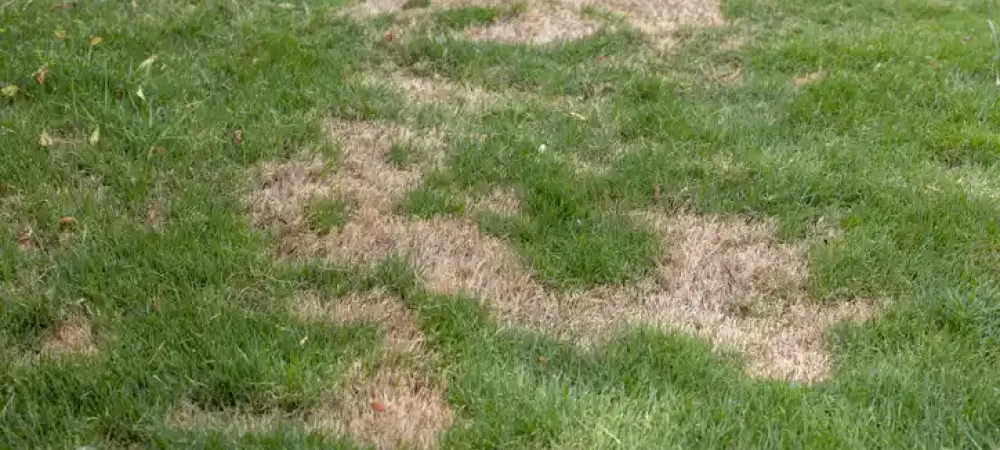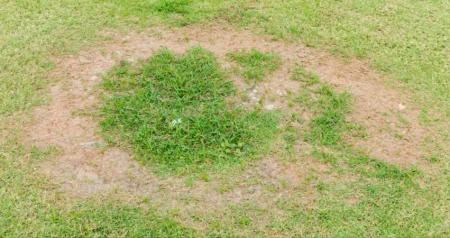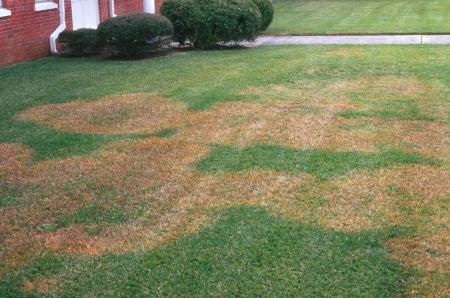
Brown Patch in Georgia: Identification and Treatment
Brown patch affects lawns in Georgia, particularly during warm, humid conditions. It causes circular patches of dead grass that can quickly spread if left untreated. Identifying brown patch early and implementing proper treatment methods are crucial for maintaining a healthy, vibrant lawn in Georgia's climate.
What is Brown Patch?
Brown patch is a fungal disease caused by Rhizoctonia solani that primarily affects cool-season grasses in Georgia, such as tall fescue and ryegrass. It can also impact warm-season grasses like St. Augustine and zoysia during periods of high humidity and temperatures. This disease thrives in conditions where nighttime temperatures are above 68°F and daytime temperatures are between 80-85°F, making Georgia's climate ideal for its development.
Key Signs of Brown Patch in Georgia Lawns
Recognizing the symptoms of brown patch is essential for early intervention. Here are the primary indicators:

- Circular patches of discolored grass - Look for round areas of tan or brown grass, ranging from a few inches to several feet in diameter.
- Distinctive "smoke ring" border - Often, the edges of affected areas will have a dark, water-soaked appearance, creating a ring-like effect.
- Thinning grass blades - Grass may appear thinner and less dense than surrounding healthy turf.
Types of Grass Affected by Brown Patch in Georgia
Cool-Season Grasses
- Description: Grasses that grow best in cooler temperatures
- Best for: Lawns in northern Georgia or shaded areas
- Pros and cons: Lush appearance but more susceptible to brown patch in Georgia's heat
Warm-Season Grasses
- Description: Grasses adapted to hot, humid climates
- Best for: Most Georgia lawns, especially in central and southern regions
- Pros and cons: More resistant to brown patch but can still be affected during periods of high humidity
How to Treat Brown Patch in Georgia Lawns
Effective treatment of brown patch involves a combination of cultural practices and, when necessary, fungicide applications. Here's what you can do to prevent and treat brown patch:
- Improve air circulation: Prune nearby trees and shrubs to increase sunlight and airflow to your lawn.
- Adjust watering habits: Water deeply but infrequently, preferably in the early morning to allow grass to dry during the day.
- Maintain proper mowing height: Keep grass at the upper end of its recommended height to promote deeper root growth and resilience.
- Apply fungicides: For severe cases, use a fungicide containing active ingredients like azoxystrobin, propiconazole, or fluoxastrobin. Always follow label instructions carefully.
Georgia-Specific Considerations for Brown Patch
When dealing with brown patch in Georgia, keep these local factors in mind:

- Humidity levels: Georgia's high humidity creates ideal conditions for fungal growth, especially in late spring and early fall.
- Seasonal transitions: Be extra vigilant during transitions between seasons when temperature and moisture levels fluctuate.
- Soil type: Georgia's clay-heavy soils can retain moisture, potentially exacerbating brown patch issues. Consider improving drainage in problem areas.
Common Mistakes to Avoid
Steer clear of these common mistakes people make when trying to manage brown patch:
- Overwatering: Excess moisture creates the perfect environment for fungal growth. Adjust your irrigation system to avoid this common pitfall.
- Ignoring early signs: Delaying treatment can allow brown patch to spread rapidly. Act quickly at the first signs of discoloration.
- Over-fertilizing: Too much nitrogen, especially during warm, humid periods, can promote brown patch development. Follow a balanced fertilization schedule.
Frequently Asked Questions
Q: Can brown patch kill my entire lawn?
A: While brown patch rarely kills an entire lawn, it can cause significant damage if left untreated. Prompt identification and treatment are key to preventing widespread turf loss.
Q: How often should I apply fungicide for brown patch?
A: Fungicide application frequency depends on the severity of the infection and the product used. Generally, treatments are applied every 14-28 days during high-risk periods. Always follow the manufacturer's instructions for best results.
Q: Is brown patch contagious to other plants in my garden?
A: Brown patch primarily affects turfgrass and doesn't typically spread to other garden plants. However, maintaining overall garden health can help prevent various fungal diseases from taking hold.
Professional Lawn Care Services in Georgia
Managing brown patch and maintaining a healthy lawn can be challenging in Georgia's climate. If you're struggling with persistent fungal issues or want to ensure your lawn receives the best care possible, consider contacting the experts at Legacy Lawn Care. Our team of experienced professionals can provide tailored solutions for your specific lawn needs, from disease prevention to comprehensive maintenance programs.
Last updated: 12/24/2025

